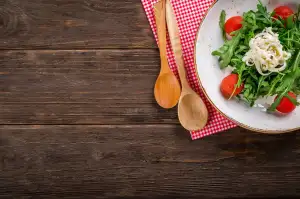Master the Art of Cleaning a Cast Iron Pan: Essential Tips for Home Cooks

- Gather necessary supplies: coarse salt, paper towels, hot water, mild dish soap, scrub brush, and a clean towel.
- Allow the cast iron pan to cool down before cleaning to avoid warping.
- Sprinkle coarse salt on the pan's surface to act as a gentle abrasive.
- Use a paper towel to scrub the salt around the pan, removing any food residue.
- Rinse the pan under hot water, avoiding the use of soap at this stage.
- For stubborn residue, add a small amount of mild dish soap and scrub with a brush.
- Rinse the pan thoroughly to remove all soap residue.
- Dry the pan completely with a clean towel to prevent rusting.
- Apply a thin layer of oil to the pan to season and protect it before storing.
Gather necessary supplies: coarse salt, paper towels, hot water, mild dish soap, scrub brush, and a clean towel.
To master the art of cleaning a cast iron pan effectively, it's essential to gather the necessary supplies beforehand. You will need coarse salt to act as a gentle abrasive, paper towels for wiping and scrubbing, hot water for rinsing, mild dish soap for stubborn residue, a scrub brush for thorough cleaning, and a clean towel for drying. Having these supplies ready will make the cleaning process smooth and efficient.
Allow the cast iron pan to cool down before cleaning to avoid warping.
Allowing the cast iron pan to cool down before cleaning is crucial to prevent warping. Cast iron pans are known for their durability, but sudden temperature changes can cause them to warp. When a hot pan comes into contact with cold water or cleaning agents, it can lead to thermal shock and damage the pan's structure. To avoid this, always let the pan cool naturally before beginning the cleaning process. This simple step will help maintain the integrity of your cast iron cookware for years to come.
Sprinkle coarse salt on the pan's surface to act as a gentle abrasive.
Sprinkling coarse salt on the surface of your cast iron pan is a simple yet effective way to act as a gentle abrasive during the cleaning process. The coarse texture of the salt helps to loosen any stuck-on food particles without damaging the seasoning of the pan. This method is particularly useful for removing stubborn residue without the need for harsh chemicals or abrasive scrubbers. By gently scrubbing the salt around the pan with a paper towel, you can lift off any food remnants and ensure that your cast iron pan remains in top condition.
Use a paper towel to scrub the salt around the pan, removing any food residue.
After sprinkling coarse salt on the surface of your cast iron pan, take a paper towel and start scrubbing the salt around the pan. The coarse texture of the salt will act as a gentle abrasive, helping to loosen and remove any stubborn food residue that may be stuck on the pan. Be sure to scrub all areas of the pan thoroughly to ensure that it is clean and free from any leftover food particles. This step is crucial in maintaining the quality and longevity of your cast iron cookware.
Rinse the pan under hot water, avoiding the use of soap at this stage.
After scrubbing the pan with salt to remove any food residue, it's time to rinse it under hot water. Avoid using soap at this stage as it can strip away the pan's seasoning, which is crucial for maintaining its non-stick surface and preventing rust. The hot water will help to loosen any remaining bits of food without compromising the pan's seasoning. Be sure to thoroughly rinse off all the salt and food particles before moving on to the next step in cleaning your cast iron pan.
For stubborn residue, add a small amount of mild dish soap and scrub with a brush.
For stubborn residue, it's acceptable to introduce a small amount of mild dish soap into the cleaning process. The soap can help break down tough food particles that may be stuck on the surface of the cast iron pan. After adding the soap, use a scrub brush to gently work on the stubborn residue. Be cautious not to scrub too vigorously as this could potentially damage the seasoning of the pan. Once you've tackled the residue, rinse the pan thoroughly under hot water to ensure all soap residue is removed before drying it completely with a clean towel.
Rinse the pan thoroughly to remove all soap residue.
After scrubbing the cast iron pan with mild dish soap to tackle stubborn residue, it is crucial to rinse the pan thoroughly under hot water. This step is essential to ensure that all soap residue is completely removed from the surface of the pan. Any leftover soap can affect the flavor of future dishes cooked in the pan and may also cause unwanted suds or bubbles when cooking. Thorough rinsing will help maintain the integrity of your cast iron cookware and prevent any soapy taste from transferring to your food.
Dry the pan completely with a clean towel to prevent rusting.
After rinsing the cast iron pan thoroughly to remove all soap residue, it is crucial to dry it completely with a clean towel. Any remaining moisture left on the pan can lead to rusting, which can damage the pan over time. By ensuring that the pan is thoroughly dried, you are taking a proactive step in maintaining its quality and extending its lifespan. Remember, a well-dried cast iron pan is a happy and rust-free one!
Apply a thin layer of oil to the pan to season and protect it before storing.
After cleaning and drying your cast iron pan, it's crucial to apply a thin layer of oil to season and protect it before storing. This process helps maintain the pan's non-stick surface and prevents rusting. You can use any high smoke-point oil like vegetable oil or flaxseed oil. Simply pour a small amount of oil onto a paper towel and rub it all over the pan, including the handle and exterior. Make sure to coat the entire surface evenly. Store the pan in a dry place to avoid moisture buildup, which can lead to rust formation. Properly seasoned cast iron pans can last for generations with proper care.
Published: 26. 04. 2024
Category: Home



